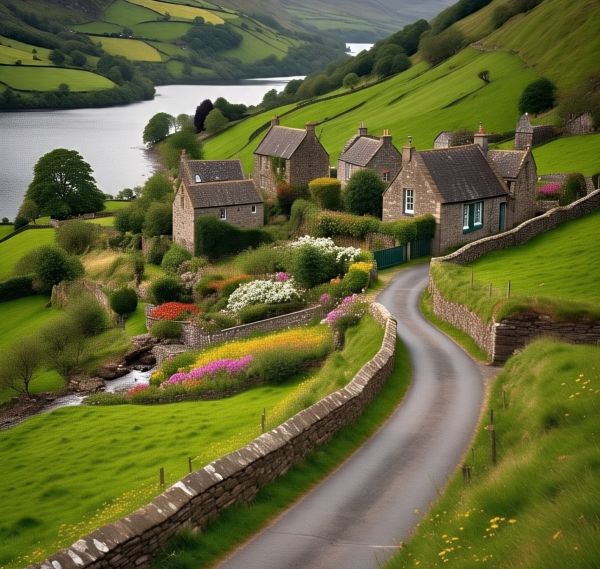Saturday, July 5, 2025
DUNNING, SCOTLAND – Tucked away in the heart of Perthshire, just ten miles from the bustling city of Perth, the quiet village of Dunning offers something that’s becoming increasingly rare in modern tourism: authenticity. Home to only 950 residents as of the 2020 census, this small settlement stands as a living archive of ancient myths, forgotten stories, and cultural richness that stretch back to the Iron Age.
Traces of Antiquity: Where History Runs Deep
For travelers with a passion for history, Dunning is a treasure waiting to be uncovered. It’s widely believed that the village’s name is derived from the Old Irish word dúnán, which translates to “little fort”—a nod to a presumed Iron Age stronghold that once stood here.
Adding to its historical depth is evidence that a Roman camp was established in the area during the first century. But what truly sets Dunning apart is its legendary association with Saint Serf, a religious figure venerated in Catholic, Scottish Episcopal, and Eastern Orthodox traditions. Folklore claims that Saint Serf slew a dragon right here in Dunning, lending a mythical charm to the village that continues to capture imaginations across the globe.
St Serf’s Church: Sacred Ground and Living Heritage
Standing proudly in the heart of the village is St Serf’s Church, an architectural gem with roots dating back to the 12th century. Although much of its visible structure was reconstructed in the early 19th century, the church’s medieval soul remains intact. While no longer an active religious site since 1972, the building is now under the care of Historic Scotland and welcomes visitors free of charge.
Inside the church rests one of Scotland’s most significant relics—the Dupplin Cross. This intricately carved Pictish stone, believed to have been created around 800 AD, not only holds deep historical value but also represents a key artifact for enthusiasts of early medieval European art. When proposals surfaced to move the cross out of Dunning, the local community rallied fiercely to keep it where it belongs, showing a strong dedication to protecting their heritage—a sentiment that resonates strongly with the principles of sustainable tourism.
The Enigma of Maggie Wall
Just beyond the village boundary lies one of Dunning’s most haunting sites—the Maggie Wall Memorial. This 20-foot-high stone monument, topped with a cross and inscribed with the chilling words “Maggie Wall burnt here 1657 as a witch,” draws curious visitors from around the world.
Yet, the mystery deepens: no historical records confirm that a woman named Maggie Wall was ever tried or executed for witchcraft. Historians remain divided. Some suggest the monument may serve as a symbolic tribute to the estimated 1,500 women who were burned during Scotland’s witch trials between the 1500s and 1700s. Others believe that Maggie Wall may have been real, her story simply lost to time. This enduring mystery offers a powerful lens into Scotland’s darker past, making the site an emotionally compelling stop for culturally engaged travelers.
From Rails to Roads: The Journey to Dunning
Although a section of the Scottish Central Railway passes close to Dunning, the village’s own train station was decommissioned in 1956, more than a century after it first opened. Today, reaching Dunning requires either a bus ride or a drive from Perth. While this lack of direct rail access might be viewed as an obstacle, it also adds to the village’s remote charm, making the journey feel like a pilgrimage into Scotland’s layered past.
Shifting Tides: What Dunning Tells Us About Travel Today
As global travelers become more discerning, places like Dunning are gaining newfound importance. There is a growing trend toward micro-destinations—smaller locales that offer deep cultural experiences away from the crowded tourist hubs.
This shift in traveler behavior has several implications:
- More focus on developing rural travel experiences
- Increased investment in preserving heritage sites
- Higher demand for genuine, immersive cultural journeys
In this context, Dunning serves as a perfect model for how heritage and tourism can coexist respectfully and sustainably.
Redefining the Travel Map: Lessons from a Quiet Village
What makes Dunning especially valuable is how it challenges the traditional definition of a tourist destination. In an age where vacations are often curated by algorithms and social media trends, Dunning stands as a testament to the beauty of slow, meaningful travel. Its ancient stories, unrecorded legends, and spirit of community guardianship offer something money can’t buy: connection.
For the travel industry, this signals the need to:
- Promote lesser-known historical sites
- Support storytelling rooted in local tradition
- Shift from surface-level sightseeing to experience-rich exploration
Why the World Should Pay Attention to Dunning
More than just a village, Dunning is a cultural waypoint. It blends Iron Age origins, Roman footprints, Christian sacred spaces, and folkloric mystery into one compact, unforgettable destination. Whether drawn by the legend of Saint Serf, the mystery surrounding Maggie Wall, or the artistry of the Dupplin Cross, visitors leave with more than photographs—they take away perspective.
In a rapidly modernizing travel landscape, Dunning stands quietly, reminding the world that sometimes, the smallest places hold the deepest stories.
«Enjoyed this post? Never miss out on future posts by following us»
